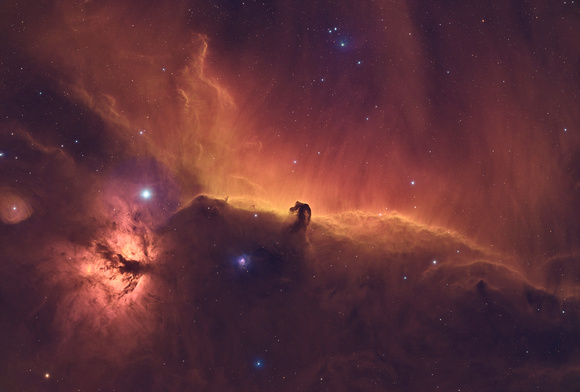Horsehead (B33) and Flame (Sh2-277) Nebulae (Orion)
Horsehead and Flame Nebulae (Narrowband HSO)
Askar 151phq; AP Mach2 GTO
ASI6200MM, - Baader 6.5nm NB CMOS opt. filters
H,S,O: (43,44,39 x 420s Bin 1, Gain 200)
Total integration time = 14.7 hrs (Oct 2023)
Yes this is yet another image of one of the most photographed deep sky targets in the night sky. Perhaps the reasons for this is that is both beautiful, and at the same time very unconventional looking in terms of a molecular cloud / star forming region. Where is the central star cluster? Where is the O3 signal created by the star cluster? Why is it so linear as opposed to more circular?
Why am I told that the interesting, linear, radiating lines of signal from behind the horsehead are caused by hydrogen ions following magnetic field lines. Ha signal isn’t formed by hydrogen ions, rather they are created by hydrogen atoms/molecules so that explanation doesn’t really work. More importantly, what is creating this magnetic field? We do see them - just on the tips of elephant trunks and other molecular cloud instability prominences – in other star forming regions, but not to this extent.
Why do we see a star that, apparently from its reflection pattern, just barely struggles to get through the molecular cloud. While I understand this one, why is this kind of thing so rare? It does add very much to the charm of the scene, and at least its blue yields some stark colour contrast. Alnitak, on the other hand, is a real pain to deal with processing wise as it just given weird reflections, diffraction spikes, and massive halos and if the gods were really trying to create an ideal photogenic space-scape, they could have toned it down a little – as it almost always detracts from the flame nebula, which in my opinion is the real star of the show and not the horse’s butt (with the horse walking away from us while looking to the left).
I do have to say, though, that the layers of bright and dark nebula do make this a fabulous target. In this version, I decided to go a bit unconventional, though, and use a HSO palette rather than the more standard SHO, Hubble one. I certainly did a better job on this version, than the one I took 2 years ago.


